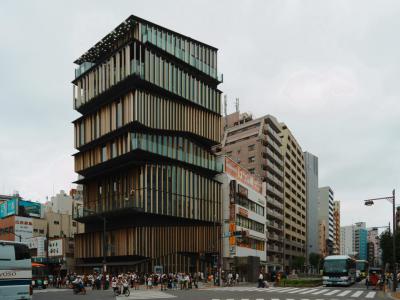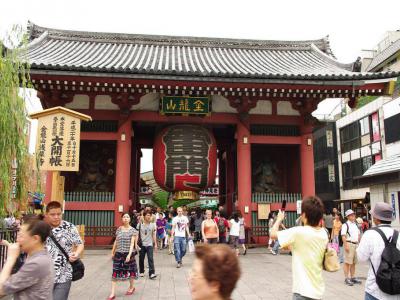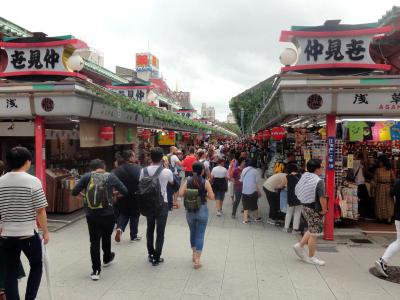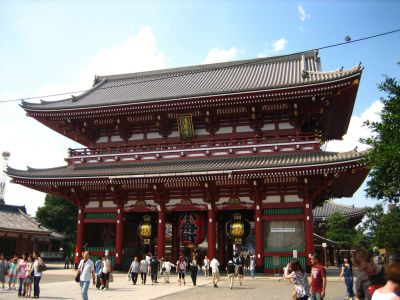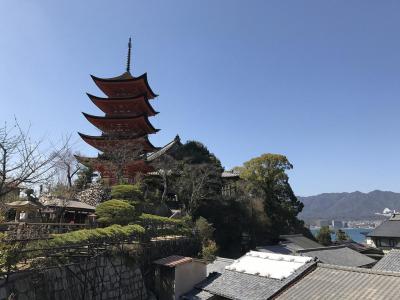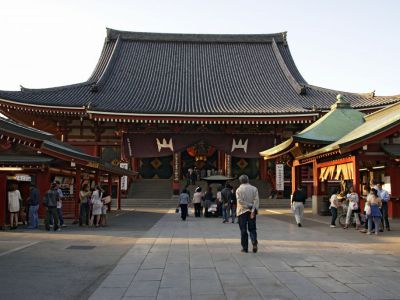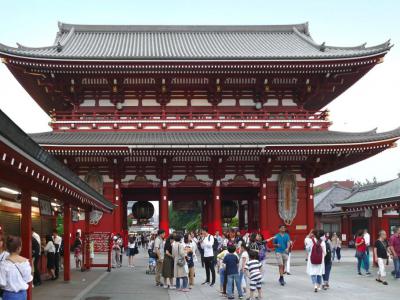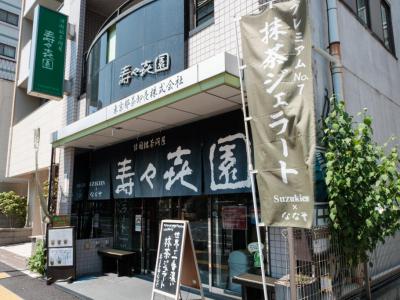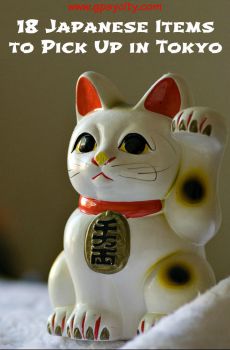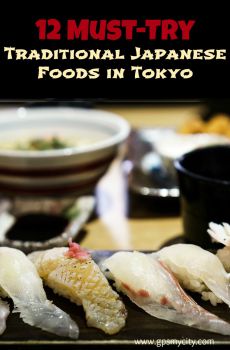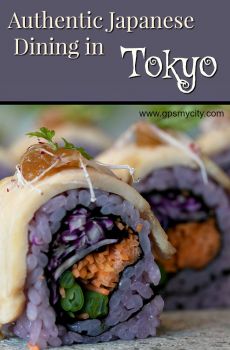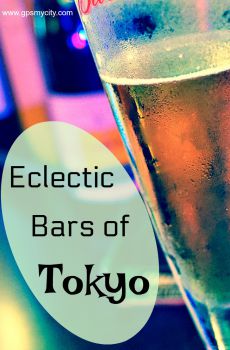Audio Guide: Asakusa District Walking Tour (Self Guided), Tokyo
Asakusa - Tokyo’s delightful time machine with a modern metro stop. This is one of the rare areas in the city where you will find narrow alleys, traditional shops, temple markets, and geisha whispers still echoing off the rooftops. Think of it as Old Tokyo in HD.
Back in the Edo period (between 1603 and 1868), Asakusa got its groove thanks to some very rich guys - the rice storehouse keepers - who turned their grains into gains, spent freely, and boom - theaters, geisha houses, and general fabulousness sprouted up.
Later, in the 20th century, Asakusa's “Sixth District” was all the rage - with cinemas like Denkikan lighting up the scene. The 1930 novel “The Scarlet Gang of Asakusa” captured the vibe - kind of like the Tokyo version of West Side Story, but with more kimonos. World War II bombings tried to dim the lights, but Asakusa rose again like a phoenix in geta sandals.
Start your journey at the sleek and helpful Asakusa Culture Tourist Information Center - the place where you pretend to check the map while planning your snack attack.
Speaking of icons, the Thunder Gate welcomes you with flair and a photo op. March through to Nakamise Street, where your wallet will scream and your taste buds will sing. Souvenirs, street food, and possibly the best rice crackers of your life await there.
Keep going and you'll meet the mighty Hozomon Gate and the elegant five-story Gojunoto pagoda - basically architectural selfies of ancient Japan.
And then… the main event: Senso-ji Temple. It’s bright red, deeply spiritual, and just photogenic enough to make your Instagram followers envious. Next door, the more peaceful Asakusa Shrine brings a Shinto vibe to your cultural bingo card.
Need a break? Hit Suzukien Teashop for matcha ice cream so rich it should have its own Netflix special. Then stroll over to the Ichikawa Danjuro IX statue - a tribute to Kabuki royalty and eyebrow game excellence.
Feeling playful? Hanayashiki Amusement Park is your retro rollercoaster escape, charmingly chaotic and perfect for all ages, including “ageless in denial.”
So there you have it - Asakusa: a neighborhood where centuries overlap, matcha flows freely, and every step feels like a well-directed historical drama. Take our self-guided walking tour and immerse yourself in a carnival of culture, temples, snacks, and sensory joy!
Back in the Edo period (between 1603 and 1868), Asakusa got its groove thanks to some very rich guys - the rice storehouse keepers - who turned their grains into gains, spent freely, and boom - theaters, geisha houses, and general fabulousness sprouted up.
Later, in the 20th century, Asakusa's “Sixth District” was all the rage - with cinemas like Denkikan lighting up the scene. The 1930 novel “The Scarlet Gang of Asakusa” captured the vibe - kind of like the Tokyo version of West Side Story, but with more kimonos. World War II bombings tried to dim the lights, but Asakusa rose again like a phoenix in geta sandals.
Start your journey at the sleek and helpful Asakusa Culture Tourist Information Center - the place where you pretend to check the map while planning your snack attack.
Speaking of icons, the Thunder Gate welcomes you with flair and a photo op. March through to Nakamise Street, where your wallet will scream and your taste buds will sing. Souvenirs, street food, and possibly the best rice crackers of your life await there.
Keep going and you'll meet the mighty Hozomon Gate and the elegant five-story Gojunoto pagoda - basically architectural selfies of ancient Japan.
And then… the main event: Senso-ji Temple. It’s bright red, deeply spiritual, and just photogenic enough to make your Instagram followers envious. Next door, the more peaceful Asakusa Shrine brings a Shinto vibe to your cultural bingo card.
Need a break? Hit Suzukien Teashop for matcha ice cream so rich it should have its own Netflix special. Then stroll over to the Ichikawa Danjuro IX statue - a tribute to Kabuki royalty and eyebrow game excellence.
Feeling playful? Hanayashiki Amusement Park is your retro rollercoaster escape, charmingly chaotic and perfect for all ages, including “ageless in denial.”
So there you have it - Asakusa: a neighborhood where centuries overlap, matcha flows freely, and every step feels like a well-directed historical drama. Take our self-guided walking tour and immerse yourself in a carnival of culture, temples, snacks, and sensory joy!
How it works: Download the app "GPSmyCity: Walks in 1K+ Cities" from Apple App Store or Google Play Store to your mobile phone or tablet. The app turns your mobile device into a personal tour guide and its built-in GPS navigation functions guide you from one tour stop to next. The app works offline, so no data plan is needed when traveling abroad.
Asakusa District Walking Tour Map
Guide Name: Asakusa District Walking Tour
Guide Location: Japan » Tokyo (See other walking tours in Tokyo)
Guide Type: Self-guided Walking Tour (Sightseeing)
# of Attractions: 10
Tour Duration: 1 Hour(s)
Travel Distance: 1.1 Km or 0.7 Miles
Author: DanaOffice
Sight(s) Featured in This Guide:
Guide Location: Japan » Tokyo (See other walking tours in Tokyo)
Guide Type: Self-guided Walking Tour (Sightseeing)
# of Attractions: 10
Tour Duration: 1 Hour(s)
Travel Distance: 1.1 Km or 0.7 Miles
Author: DanaOffice
Sight(s) Featured in This Guide:
- Asakusa Culture Tourist Information Center
- Kaminarimon Gate (Thunder Gate)
- Nakamise Shopping Street
- Hōzōmon Gate
- Gojunoto
- Senso-ji Temple
- Asakusa Shrine
- Suzukien Teashop (Matcha Ice Cream)
- Ichikawa Danjuro IX Statue
- Hanayashiki
1) Asakusa Culture Tourist Information Center
If you think "tourist information center" means beige walls and dusty pamphlets, think again. The Asakusa Culture Information Center is Tokyo’s way of saying, “Let me impress you and tell you where the nearest ramen shop is.”
Indeed, this eight-story stunner, designed by architectural rockstar Kengo Kuma and unveiled in 2012, is the perfect launchpad to explore the historic Asakusa district. It blends traditional Japanese vibes with a modern edge. Think: a stack of stylish wooden townhouses (once common in the area) playing Jenga, if Jenga had an eye for design and cultural outreach.
Perched conveniently across from the iconic Kaminari-mon Gate, the center is practically impossible to miss-unless you’re walking with your eyes closed. (Please don’t.)
Inside, it's all warm wood, minimal fuss, and maximum helpfulness. The multilingual staff is ready with maps, brochures galore, travel tips, and restaurant recommendations, not to mention the occasional lifesaving restroom direction.
But wait, there’s more! Head up to the 8th floor, and you’ll be rewarded with a free-yes, completely free of charge-panoramic view of Senso-ji Temple, Nakamise Street, and the mighty Tokyo Skytree, all in one sweeping glance. It’s the perfect place to catch your breath and fill your camera roll.
And because we all love a good multitasker, this place also hooks you up with clean toilets, free Wi-Fi, and even currency exchange. It’s basically the Swiss Army knife of visitor centers-if Swiss Army knives were made of glass and timber and looked this cool.
In short: stylish, practical, photogenic, and helpful, the Asakusa Culture Information Center has your back as part travel hub, part modern art, and 100% worth the visit. Come for the info, stay for the skyline...
Indeed, this eight-story stunner, designed by architectural rockstar Kengo Kuma and unveiled in 2012, is the perfect launchpad to explore the historic Asakusa district. It blends traditional Japanese vibes with a modern edge. Think: a stack of stylish wooden townhouses (once common in the area) playing Jenga, if Jenga had an eye for design and cultural outreach.
Perched conveniently across from the iconic Kaminari-mon Gate, the center is practically impossible to miss-unless you’re walking with your eyes closed. (Please don’t.)
Inside, it's all warm wood, minimal fuss, and maximum helpfulness. The multilingual staff is ready with maps, brochures galore, travel tips, and restaurant recommendations, not to mention the occasional lifesaving restroom direction.
But wait, there’s more! Head up to the 8th floor, and you’ll be rewarded with a free-yes, completely free of charge-panoramic view of Senso-ji Temple, Nakamise Street, and the mighty Tokyo Skytree, all in one sweeping glance. It’s the perfect place to catch your breath and fill your camera roll.
And because we all love a good multitasker, this place also hooks you up with clean toilets, free Wi-Fi, and even currency exchange. It’s basically the Swiss Army knife of visitor centers-if Swiss Army knives were made of glass and timber and looked this cool.
In short: stylish, practical, photogenic, and helpful, the Asakusa Culture Information Center has your back as part travel hub, part modern art, and 100% worth the visit. Come for the info, stay for the skyline...
2) Kaminarimon Gate (Thunder Gate)
Behold the Kaminarimon-the dramatic, lantern-swinging, statue-guarded welcome mat to Tokyo’s Senso-ji Temple. Literally translating to “Thunder Gate”, this full-blown entrance experience is bold, iconic, and packing centuries of history under its massive red lantern.
This legendary landmark was first built way back in 942-yes, nine-freakin’-forty-two-by a samurai named Taira no Kinmasa. It had moved around a bit since then (because gates also have their dreams) before landing in its current spot in 1635. Sadly, it went up in smoke a few years later-in 1639-but was fortunately resurrected! The shogun Tokugawa Iemitsu made sure it came back better than ever. Furthermore, in 1960, it had another facelift-a sleek renovation that gave us the Kaminarimon we see today.
Standing a proud 11+ meters tall and just as many meters wide, it’s flanked by four divine bouncers. Up front: Fujin, the God of Wind, and Raijin, the God of Thunder-because “welcome” sounds more convincing if reinforced by a stare down from such a weather duo. On the flip side, you’ve got Tenryu and Kinryu, Buddhist protectors offering peace, health, and a sprinkle of good fortune.
Center stage is a giant, red paper lantern called a Chochin, so big it could probably have its own postal code. Donated by none other than the founder of Panasonic, it bears the name “Kaminarimon” on the front, while the gate’s official title, “Furaijinmon,” is inscribed on the back. Oh, and don’t miss the wooden dragon at the base. Fancy stuff.
Ultimately, this gate is an absolute must-snap photo op, especially if you're hunting for that "I went to Tokyo" kind of shot. Plus, the area around it is a treasure trove of tasty street eats and local charm.
Tip:
Catch it at night when the lantern glows gloriously, the crowd dips, and the Thunder Gate turns into a calm, magical beacon in the heart of Asakusa.
This legendary landmark was first built way back in 942-yes, nine-freakin’-forty-two-by a samurai named Taira no Kinmasa. It had moved around a bit since then (because gates also have their dreams) before landing in its current spot in 1635. Sadly, it went up in smoke a few years later-in 1639-but was fortunately resurrected! The shogun Tokugawa Iemitsu made sure it came back better than ever. Furthermore, in 1960, it had another facelift-a sleek renovation that gave us the Kaminarimon we see today.
Standing a proud 11+ meters tall and just as many meters wide, it’s flanked by four divine bouncers. Up front: Fujin, the God of Wind, and Raijin, the God of Thunder-because “welcome” sounds more convincing if reinforced by a stare down from such a weather duo. On the flip side, you’ve got Tenryu and Kinryu, Buddhist protectors offering peace, health, and a sprinkle of good fortune.
Center stage is a giant, red paper lantern called a Chochin, so big it could probably have its own postal code. Donated by none other than the founder of Panasonic, it bears the name “Kaminarimon” on the front, while the gate’s official title, “Furaijinmon,” is inscribed on the back. Oh, and don’t miss the wooden dragon at the base. Fancy stuff.
Ultimately, this gate is an absolute must-snap photo op, especially if you're hunting for that "I went to Tokyo" kind of shot. Plus, the area around it is a treasure trove of tasty street eats and local charm.
Tip:
Catch it at night when the lantern glows gloriously, the crowd dips, and the Thunder Gate turns into a calm, magical beacon in the heart of Asakusa.
3) Nakamise Shopping Street
Step right up and take a stroll down Nakamise-dori-the grand catwalk of Asakusa’s shopping scene, where history, snacks, and souvenirs collide in the most delightful way. This lively 250-meter stretch connects the famous Kaminarimon Gate to the even more famous Senso-ji Temple, and it's been charming both locals and wide-eyed visitors since 1685. Yeah, this place has been slinging snacks and trinkets longer than most countries have been around.
Back in the day, temple affiliates were given the green light to set up shop-as long as they kept the place tidy. Think of it as early Tokyo’s homeowners association-meeting-Etsy setup. By 1885, the government decided to zhuzh things up with brick and vermilion-lacquered storefronts. Unfortunately, those didn’t survive the Great Kanto Earthquake of 1923 or World War II, but like a true Tokyo icon, Nakamise-dori rose again-stronger, snackier, and more souvenir-packed than ever.
These days, nearly 90 shops line the path, each one tempting you with something uniquely Japanese. There, you’ve got adorable little baked sweets shaped like dolls, handmade rice crackers that crackle louder than your knees, and all sorts of masks, crafts, and casual kimonos for that “just dropped into a festival” look. Even pro performers swing by to pick up their dance and theater gear-because yes, kabuki actors, like anybody else, need retail therapy.
You may want to visit here hunting for that perfect keepsake, craving some street food, or just seeking to bask in the festive vibes this street delivers. So walk, snack, shop, and repeat. Nakamise-dori isn’t just a street-it’s a whole experience with a side of history and a dusting of powdered sugar.
Tip:
Bring cash, as most of these charming shops are gloriously old-school-which means your credit card is about as useful here as a chocolate teapot.
Back in the day, temple affiliates were given the green light to set up shop-as long as they kept the place tidy. Think of it as early Tokyo’s homeowners association-meeting-Etsy setup. By 1885, the government decided to zhuzh things up with brick and vermilion-lacquered storefronts. Unfortunately, those didn’t survive the Great Kanto Earthquake of 1923 or World War II, but like a true Tokyo icon, Nakamise-dori rose again-stronger, snackier, and more souvenir-packed than ever.
These days, nearly 90 shops line the path, each one tempting you with something uniquely Japanese. There, you’ve got adorable little baked sweets shaped like dolls, handmade rice crackers that crackle louder than your knees, and all sorts of masks, crafts, and casual kimonos for that “just dropped into a festival” look. Even pro performers swing by to pick up their dance and theater gear-because yes, kabuki actors, like anybody else, need retail therapy.
You may want to visit here hunting for that perfect keepsake, craving some street food, or just seeking to bask in the festive vibes this street delivers. So walk, snack, shop, and repeat. Nakamise-dori isn’t just a street-it’s a whole experience with a side of history and a dusting of powdered sugar.
Tip:
Bring cash, as most of these charming shops are gloriously old-school-which means your credit card is about as useful here as a chocolate teapot.
4) Hōzōmon Gate
Next stop on your Asakusa adventure is the Hōzōmon Gate-part grand entrance, part historical vault, and all-around scene-stealer at Senso-ji Temple.
Now, don’t let the elegant red facade fool you-this gate has seen things. Big things. Originally built way back in 942 by military man Taira no Kinmasa-who, legend has it, landed his dream job as Lord of Tokyo thanks to a few strategic prayers at Senso-ji-this gate was his giant “thank you” card. Unfortunately, it didn’t last forever. Fire took the original out in 1631. Luckily, Tokugawa Iemitsu, the 3rd Shogun, who said, “No worries, I got this,” had it rebuilt-only for World War II to throw another fiery tantrum.
But like any great action hero, the Hōzōmon returned stronger. Today’s version is steel-reinforced and fire-resistant, built to protect not just history-but literal treasures.
Speaking of which: inside the upper floor, check out a veritable Buddhist treasure chest. We’re talking a copy of the Lotus Sutra (national treasure, mind you!), and the Issai Kyo, the ultimate Buddhist script collection, officially labeled an Important Cultural Property. Yep, capital letters and everything...
But that’s not all. Standing guard are two towering 5.5-meter-tall Nio statues-basically Buddha’s bodyguards with permanent scowls and a serious gym routine. Look up, and you’ll see three huge (each weighing a ton of kilos!) lanterns, including a fire-engine red chochin lantern donated in 2003 to mark 400 years since the Edo period kicked off. Nice touch, right?
And if you’re wondering about the giant straw sandals hanging at the back? Those are the Waraji-massive, traditional footwear meant for the Nio guardians. Because even statues need to walk in style.
So there you have it-Hōzōmon: part gateway, part time capsule, all drama.
Now, don’t let the elegant red facade fool you-this gate has seen things. Big things. Originally built way back in 942 by military man Taira no Kinmasa-who, legend has it, landed his dream job as Lord of Tokyo thanks to a few strategic prayers at Senso-ji-this gate was his giant “thank you” card. Unfortunately, it didn’t last forever. Fire took the original out in 1631. Luckily, Tokugawa Iemitsu, the 3rd Shogun, who said, “No worries, I got this,” had it rebuilt-only for World War II to throw another fiery tantrum.
But like any great action hero, the Hōzōmon returned stronger. Today’s version is steel-reinforced and fire-resistant, built to protect not just history-but literal treasures.
Speaking of which: inside the upper floor, check out a veritable Buddhist treasure chest. We’re talking a copy of the Lotus Sutra (national treasure, mind you!), and the Issai Kyo, the ultimate Buddhist script collection, officially labeled an Important Cultural Property. Yep, capital letters and everything...
But that’s not all. Standing guard are two towering 5.5-meter-tall Nio statues-basically Buddha’s bodyguards with permanent scowls and a serious gym routine. Look up, and you’ll see three huge (each weighing a ton of kilos!) lanterns, including a fire-engine red chochin lantern donated in 2003 to mark 400 years since the Edo period kicked off. Nice touch, right?
And if you’re wondering about the giant straw sandals hanging at the back? Those are the Waraji-massive, traditional footwear meant for the Nio guardians. Because even statues need to walk in style.
So there you have it-Hōzōmon: part gateway, part time capsule, all drama.
5) Gojunoto
Now, if you’re wandering through Asakusa and spot a tall, tiered beauty looking like it’s reaching for the heavens-congrats, you’ve found the Gojunoto, a.k.a. the Five-storied Pagoda at Senso-ji Temple. It’s not just another pretty face in the skyline; it’s the second-tallest pagoda in all of Japan. (First place goes to Kyoto’s Toji Temple-but hey, silver's still a win.)
The Gojunoto’s history reads like a dramatic epic. The original pagoda dates back to 942, courtesy of military commander Taira no Kinmasa-because nothing says “don’t mess with me” more explicitly than building a towering spiritual monument. That one went up in flames, sadly, and in 1650, Tokugawa Iemitsu decided it was time for a sequel. Then came another fire in 1816, a rebuild in 1818, and by 1911, it was so legendary, Japan gave it national treasure status. Cue the sad trombone in 1945, when World War II damage struck again. But like any great icon, the Gojunoto rose once more-rebuilt in 1973 with a modern twist.
Today’s version is a fire-resistant, earthquake-savvy structure made of reinforced concrete and steel, standing tall at 53 meters. But don’t worry-it’s still got that traditional soul. At the heart is a Japanese cypress wood pillar, the secret ingredient of nearly all Japanese pagodas. The floors are loosely stacked around the core in a style known as "new Toinzukuri"-fancy talk for "this thing can shake and shimmy but won’t fall down."
Oh, and it’s not just for show. The Gojunoto also houses a lecture hall and holds a sacred tablet of the Buddha. The top floor is where the relics of the Buddha are stored, giving this architectural marvel a seriously holy vibe.
So whether you're here for the history, the engineering, or just to snap a selfie with one of Tokyo’s coolest cultural icons, the Gojunoto delivers five levels of awesomeness. Literally.
The Gojunoto’s history reads like a dramatic epic. The original pagoda dates back to 942, courtesy of military commander Taira no Kinmasa-because nothing says “don’t mess with me” more explicitly than building a towering spiritual monument. That one went up in flames, sadly, and in 1650, Tokugawa Iemitsu decided it was time for a sequel. Then came another fire in 1816, a rebuild in 1818, and by 1911, it was so legendary, Japan gave it national treasure status. Cue the sad trombone in 1945, when World War II damage struck again. But like any great icon, the Gojunoto rose once more-rebuilt in 1973 with a modern twist.
Today’s version is a fire-resistant, earthquake-savvy structure made of reinforced concrete and steel, standing tall at 53 meters. But don’t worry-it’s still got that traditional soul. At the heart is a Japanese cypress wood pillar, the secret ingredient of nearly all Japanese pagodas. The floors are loosely stacked around the core in a style known as "new Toinzukuri"-fancy talk for "this thing can shake and shimmy but won’t fall down."
Oh, and it’s not just for show. The Gojunoto also houses a lecture hall and holds a sacred tablet of the Buddha. The top floor is where the relics of the Buddha are stored, giving this architectural marvel a seriously holy vibe.
So whether you're here for the history, the engineering, or just to snap a selfie with one of Tokyo’s coolest cultural icons, the Gojunoto delivers five levels of awesomeness. Literally.
6) Senso-ji Temple (must see)
If Tokyo were a movie, Senso-ji Temple would be one of the stars-and not the flashy, one-hit-wonder type. We’re talking legendary status. Oldest temple in the city, most visited by tourists, and absolutely dripping in myth, history, and incense.
Legend has it that way back in the 7th century, two brothers were out fishing in the Sumida River when-plot twist-they pulled up a golden statue of Kannon, the Goddess of Mercy. They tried tossing her back, but she kept popping up like a divine boomerang. A local village headman got wind of this, had a spiritual epiphany, and next thing you know-bam!-temple time. That was 645 AD. Which means this place has been around longer than Tokyo itself.
Fast forward to the Edo period, and the powerful Tokugawa Shoguns swooped in with some serious upgrades and spiritual endorsements. World War II took its toll, but like any good epic, Senso-ji rose again-rebuilt by believers and still standing strong.
And yes, that original golden statue is still here. But no peeking-it's forever hidden from public view, like the temple’s best-kept secret.
Each year, over 30 million people make the pilgrimage here, not just for the views but for the vibes. Festivals are a big deal-especially Sanja Matsuri in May, when the energy is off the charts, and the Asakusa Samba Carnival in August, when Tokyo briefly turns into Rio.
Otherwise, Tokyo guests visit here for the soul of the city wrapped in centuries of history, spiritual charm, and photo ops galore.
Tip:
Wander the side streets for secret snacks and fewer crowds. And if you’re up for a little magic, come back at sundown-when the crowds fade, the lanterns glow, and the temple shows off its most photogenic side.
Legend has it that way back in the 7th century, two brothers were out fishing in the Sumida River when-plot twist-they pulled up a golden statue of Kannon, the Goddess of Mercy. They tried tossing her back, but she kept popping up like a divine boomerang. A local village headman got wind of this, had a spiritual epiphany, and next thing you know-bam!-temple time. That was 645 AD. Which means this place has been around longer than Tokyo itself.
Fast forward to the Edo period, and the powerful Tokugawa Shoguns swooped in with some serious upgrades and spiritual endorsements. World War II took its toll, but like any good epic, Senso-ji rose again-rebuilt by believers and still standing strong.
And yes, that original golden statue is still here. But no peeking-it's forever hidden from public view, like the temple’s best-kept secret.
Each year, over 30 million people make the pilgrimage here, not just for the views but for the vibes. Festivals are a big deal-especially Sanja Matsuri in May, when the energy is off the charts, and the Asakusa Samba Carnival in August, when Tokyo briefly turns into Rio.
Otherwise, Tokyo guests visit here for the soul of the city wrapped in centuries of history, spiritual charm, and photo ops galore.
Tip:
Wander the side streets for secret snacks and fewer crowds. And if you’re up for a little magic, come back at sundown-when the crowds fade, the lanterns glow, and the temple shows off its most photogenic side.
7) Asakusa Shrine
Found just east of the grand Senso-ji Temple is a quieter but no less legendary spot: the Asakusa Shrine-Tokyo’s own time capsule of Shinto serenity.
Now, this isn’t just another pretty shrine. Built in 1649 by Tokugawa Iemitsu-yes, the shogun himself-it honors three unlikely heroes: two fishermen, Hinokuma Hamanari and Hinokuma Takenari, and a village headman, Hajino Nakatomo. What did they do, you ask? Oh, nothing major-just fished the Bodhisattva Kannon out of the river and accidentally kickstarted Tokyo’s oldest temple, no big deal.
If you're impressed, so was Iemitsu, the shogun. So much so that he had this shrine built to immortalize them-literally. All three became monks and were later enshrined here as deities. Talk about a career pivot...
The shrine sits just off a small street beside Senso-ji, behind a stone gateway that basically whispers, “You’re about to enter sacred ground.” And here’s the plot twist: while much of Tokyo was flattened during World War II, Asakusa Shrine stood strong, surviving the bombing raids like a champ. In 1951, it was officially recognized as an Important Cultural Property. Fancy title, rightfully earned.
Architecturally, it rocks the Gonden-zukuri style-classic, compact, and elegant. Guarding the entrance are two stone creatures called Komainu-half-lion, half-dog, full-time evil repellents.
And if you’re in town during May, don’t miss the Sanja Matsuri. This isn’t your average neighborhood block party-it’s one of Tokyo’s top three festivals, complete with portable shrines, lively crowds, and all the energy of a city that knows how to celebrate history.
One last tip for the camera crew: You can snap pics of the shrine’s front, but no selfies inside, please. For a moodier, magical photo op, swing by after sunset-the shrine lights up like a dream.
So, next time you’re temple-trekking through Asakusa, don’t just breeze past. Asakusa Shrine is where legends rest, lions watch, and Tokyo’s soul quietly glows.
Now, this isn’t just another pretty shrine. Built in 1649 by Tokugawa Iemitsu-yes, the shogun himself-it honors three unlikely heroes: two fishermen, Hinokuma Hamanari and Hinokuma Takenari, and a village headman, Hajino Nakatomo. What did they do, you ask? Oh, nothing major-just fished the Bodhisattva Kannon out of the river and accidentally kickstarted Tokyo’s oldest temple, no big deal.
If you're impressed, so was Iemitsu, the shogun. So much so that he had this shrine built to immortalize them-literally. All three became monks and were later enshrined here as deities. Talk about a career pivot...
The shrine sits just off a small street beside Senso-ji, behind a stone gateway that basically whispers, “You’re about to enter sacred ground.” And here’s the plot twist: while much of Tokyo was flattened during World War II, Asakusa Shrine stood strong, surviving the bombing raids like a champ. In 1951, it was officially recognized as an Important Cultural Property. Fancy title, rightfully earned.
Architecturally, it rocks the Gonden-zukuri style-classic, compact, and elegant. Guarding the entrance are two stone creatures called Komainu-half-lion, half-dog, full-time evil repellents.
And if you’re in town during May, don’t miss the Sanja Matsuri. This isn’t your average neighborhood block party-it’s one of Tokyo’s top three festivals, complete with portable shrines, lively crowds, and all the energy of a city that knows how to celebrate history.
One last tip for the camera crew: You can snap pics of the shrine’s front, but no selfies inside, please. For a moodier, magical photo op, swing by after sunset-the shrine lights up like a dream.
So, next time you’re temple-trekking through Asakusa, don’t just breeze past. Asakusa Shrine is where legends rest, lions watch, and Tokyo’s soul quietly glows.
8) Suzukien Teashop (Matcha Ice Cream)
Welcome to the Suzukien Teashop-a little slice of green tea heaven tucked away in the Asakusa district-where your matcha dreams (and possibly your sinuses) come true. You’ll find this gem on Kototoi-dori Avenue, just a breezy five-minute stroll from Senso-ji Temple.
Now, this isn’t yet another average teahouse. Suzukien is where centuries-old tea traditions meet gelato. Yes, you heard that right. Tea and ice cream, living in perfect, delicious harmony.
Step inside, and you’ll find teas from all corners of Japan. Feeling mellow? Try the sweet and smooth Kinryu from Shizuoka. Need a little pick-me-up and some allergy relief? The minty Benifuki is rumored to help with seasonal sniffles. (Tea or miracle potion? You decide.)
But let’s talk gelato-because that’s where things get serious. Suzukien proudly serves what they claim is the world’s strongest matcha gelato. Grown in the misty mountains of Fujieda City, this emerald powerhouse comes in seven-yes, seven-levels of matcha intensity. From a gentle breeze to a full-on green tea thunderstorm. Not in the mood for a matcha marathon? No worries, they’ve got strawberry, black sesame, and adzuki bean waiting in the wings.
And for the souvenir hunters, Suzukien has your back. Take home beautifully packaged teas-bagged, loose leaf, or finely ground-perfect for gifting or just hoarding for yourself (nobody's judging). So go on, take a tea break. Or a gelato break. Or both. Suzukien is ready when you are.
Now, this isn’t yet another average teahouse. Suzukien is where centuries-old tea traditions meet gelato. Yes, you heard that right. Tea and ice cream, living in perfect, delicious harmony.
Step inside, and you’ll find teas from all corners of Japan. Feeling mellow? Try the sweet and smooth Kinryu from Shizuoka. Need a little pick-me-up and some allergy relief? The minty Benifuki is rumored to help with seasonal sniffles. (Tea or miracle potion? You decide.)
But let’s talk gelato-because that’s where things get serious. Suzukien proudly serves what they claim is the world’s strongest matcha gelato. Grown in the misty mountains of Fujieda City, this emerald powerhouse comes in seven-yes, seven-levels of matcha intensity. From a gentle breeze to a full-on green tea thunderstorm. Not in the mood for a matcha marathon? No worries, they’ve got strawberry, black sesame, and adzuki bean waiting in the wings.
And for the souvenir hunters, Suzukien has your back. Take home beautifully packaged teas-bagged, loose leaf, or finely ground-perfect for gifting or just hoarding for yourself (nobody's judging). So go on, take a tea break. Or a gelato break. Or both. Suzukien is ready when you are.
9) Ichikawa Danjuro IX Statue
Just steps from Tokyo’s iconic Senso-ji Temple stands a sculptural tribute, or rather a standing ovation, in bronze. Meet the Ichikawa Danjūrō IX Statue, honoring one of the absolute titans of kabuki theater. And when we say titan, we mean it. If kabuki had a Hollywood Walk of Fame, Ichikawa Danjūrō would have his own boulevard.
Now, here’s the twist: “Ichikawa Danjūrō” isn’t just one guy-it’s a legacy. A theatrical title passed down like a family crown since the 1600s. But today, we’re zooming in on number nine-Ichikawa Danjūrō IX-born in 1838, kabuki superstar, Meiji-era showman, and the man who basically saved kabuki from being swept away by Western fads and factory whistles.
This wasn’t just a guy in makeup yelling dramatically on stage. Danjūrō IX was the master of aragoto-the bold, brash, hero-style of kabuki acting. Think booming voices, dramatic poses, and enough charisma to power Tokyo Tower.
While Japan was modernizing at warp speed, ditching kimonos for suits, Danjūrō fought to keep kabuki relevant without turning it into a museum piece. He fine-tuned scripts, performed for the imperial family-a big deal-and even dipped his toes into early cinema. That’s right: Kabuki went lights, camera, eyeliner.
His portrayal of the warrior monk Benkei in Kanjinchō was legendary. His leadership at the Kabuki-za Theatre was game-changing. His influence on the future of kabuki was immeasurable.
When he passed in 1903, Japan didn’t just lose an actor-it lost a cultural guardian. But thanks to his statue (and that unforgettable name), Ichikawa Danjūrō IX still holds center stage. So next time you pass by, maybe give a little bow. After all, royalty deserves applause-even in bronze.
Now, here’s the twist: “Ichikawa Danjūrō” isn’t just one guy-it’s a legacy. A theatrical title passed down like a family crown since the 1600s. But today, we’re zooming in on number nine-Ichikawa Danjūrō IX-born in 1838, kabuki superstar, Meiji-era showman, and the man who basically saved kabuki from being swept away by Western fads and factory whistles.
This wasn’t just a guy in makeup yelling dramatically on stage. Danjūrō IX was the master of aragoto-the bold, brash, hero-style of kabuki acting. Think booming voices, dramatic poses, and enough charisma to power Tokyo Tower.
While Japan was modernizing at warp speed, ditching kimonos for suits, Danjūrō fought to keep kabuki relevant without turning it into a museum piece. He fine-tuned scripts, performed for the imperial family-a big deal-and even dipped his toes into early cinema. That’s right: Kabuki went lights, camera, eyeliner.
His portrayal of the warrior monk Benkei in Kanjinchō was legendary. His leadership at the Kabuki-za Theatre was game-changing. His influence on the future of kabuki was immeasurable.
When he passed in 1903, Japan didn’t just lose an actor-it lost a cultural guardian. But thanks to his statue (and that unforgettable name), Ichikawa Danjūrō IX still holds center stage. So next time you pass by, maybe give a little bow. After all, royalty deserves applause-even in bronze.
10) Hanayashiki
Just a short skip from the legendary Senso-ji Temple, in the retro-cool streets of Asakusa, you will find Hanayashiki Park-Japan’s oldest amusement park and a charming blend of nostalgia and quirky fun. We’re talking since-1853 kind of old. That’s right-Hanayashiki was dazzling folks back when topknots were still trending.
Originally a serene garden full of peonies and chrysanthemums, Hanayashiki slowly turned up the volume over the years. By the 1870s, it was dabbling in Western films, play gear, and even a zoo with animals so exotic, the place made national headlines. Fun fact: In 1923, five tiger cubs were born here. At once. And in 1931, Japan said hello to its first lion here.
As the country zoomed into the modern age, the flowers took a backseat, and the fun took the wheel. Post-WWII, the managing Togo Company gave the park a glow-up, adding rides, charm, and enough nostalgia to fill a time capsule.
Now, don’t let the compact size fool you-Hanayashiki packs a punch with 20+ quirky attractions. The main headliner is Japan’s oldest steel roller coaster, still click-clacking since 1953. Then there’s the haunted house that’s more delightfully weird than bone-chilling, those too-cute panda cars (for kids and adults who refuse to grow up), and good ol’ carnival classics like ring toss and shooting galleries.
Feeling snacky? Follow the scent of yakisoba, cotton candy, and soft-serve ice cream to a lineup of stalls that serve nostalgia on a stick. And when your feet need a break, head to the rooftop for chill views of Asakusa and the Tokyo Skytree. Perfect for selfies. Or existential skyline-gazing. Your call.
Who’s it for? Everyone. Families, date-night couples, curious solo wanderers-it’s a full-blown vibe. It’s not glitzy. It’s not massive. But it oozes charm, with a hint of Showa-era magic and just the right dose of kitsch.
So no, Hanayashiki isn’t trying to be Disneyland. It’s better-it’s Tokyo’s Old-Gold amusement spot, where the roller coasters are classic, the fun is heartfelt, and the smiles come with a side of sweet, old-school whimsy.
Originally a serene garden full of peonies and chrysanthemums, Hanayashiki slowly turned up the volume over the years. By the 1870s, it was dabbling in Western films, play gear, and even a zoo with animals so exotic, the place made national headlines. Fun fact: In 1923, five tiger cubs were born here. At once. And in 1931, Japan said hello to its first lion here.
As the country zoomed into the modern age, the flowers took a backseat, and the fun took the wheel. Post-WWII, the managing Togo Company gave the park a glow-up, adding rides, charm, and enough nostalgia to fill a time capsule.
Now, don’t let the compact size fool you-Hanayashiki packs a punch with 20+ quirky attractions. The main headliner is Japan’s oldest steel roller coaster, still click-clacking since 1953. Then there’s the haunted house that’s more delightfully weird than bone-chilling, those too-cute panda cars (for kids and adults who refuse to grow up), and good ol’ carnival classics like ring toss and shooting galleries.
Feeling snacky? Follow the scent of yakisoba, cotton candy, and soft-serve ice cream to a lineup of stalls that serve nostalgia on a stick. And when your feet need a break, head to the rooftop for chill views of Asakusa and the Tokyo Skytree. Perfect for selfies. Or existential skyline-gazing. Your call.
Who’s it for? Everyone. Families, date-night couples, curious solo wanderers-it’s a full-blown vibe. It’s not glitzy. It’s not massive. But it oozes charm, with a hint of Showa-era magic and just the right dose of kitsch.
So no, Hanayashiki isn’t trying to be Disneyland. It’s better-it’s Tokyo’s Old-Gold amusement spot, where the roller coasters are classic, the fun is heartfelt, and the smiles come with a side of sweet, old-school whimsy.
Walking Tours in Tokyo, Japan
Create Your Own Walk in Tokyo
Creating your own self-guided walk in Tokyo is easy and fun. Choose the city attractions that you want to see and a walk route map will be created just for you. You can even set your hotel as the start point of the walk.
Tokyo Imperial Palace Walking Tour
Welcome to Tokyo’s greenest royal secret-The Imperial Palace-a majestic sprawl of tradition, tranquility, and top-tier landscaping. This is where Japan’s Emperor hangs his crown (figuratively speaking), nestled right in the city’s beating heart and surrounded by moats like something straight out of a storybook... or a really classy samurai movie.
Now, before you grab your crown and march... view more
Tour Duration: 2 Hour(s)
Travel Distance: 2.7 Km or 1.7 Miles
Now, before you grab your crown and march... view more
Tour Duration: 2 Hour(s)
Travel Distance: 2.7 Km or 1.7 Miles
Shibuya Walking Tour
Ah, Shibuya... If Tokyo were a giant party, this district would be the dance floor. A neon-lit playground where fashion-forward teens, pop culture fiends, and wide-eyed tourists collide in a kaleidoscope of color, style, and pure urban energy.
But before it became Japan’s trendsetting capital, Shibuya had a different kind of ruling class-the Shibuya clan. Back in the 1160s, they ran this... view more
Tour Duration: 2 Hour(s)
Travel Distance: 3.9 Km or 2.4 Miles
But before it became Japan’s trendsetting capital, Shibuya had a different kind of ruling class-the Shibuya clan. Back in the 1160s, they ran this... view more
Tour Duration: 2 Hour(s)
Travel Distance: 3.9 Km or 2.4 Miles
Ginza Shopping Tour
Often compared with New York's Fifth Avenue, Ginza is the most luxurious shopping district in Tokyo. Its two main avenues running through the area, Chuo-dori Street and Harumi-dori Street, are lined with high-end boutiques, enormous department stores, and flagship stores of renowned international brands carrying a wealth of merchandise, from fashion and jewelry to electronics and cosmetics.
... view more
Tour Duration: 1 Hour(s)
Travel Distance: 1.6 Km or 1 Miles
... view more
Tour Duration: 1 Hour(s)
Travel Distance: 1.6 Km or 1 Miles
Ueno Park Walking Tour
Ueno Park is Tokyo’s ultimate mashup of history, nature, and culture! It started as part of the powerful Kanei-ji Temple during the Edo period, which lasted from 1603 to 1868. Back then, samurais roamed and shoguns ruled the country. In the 1870s, as Japan embraced modernization, the area was gentrified, turning into a public park. Today, it's a major attraction for travelers craving both a... view more
Tour Duration: 2 Hour(s)
Travel Distance: 3.9 Km or 2.4 Miles
Tour Duration: 2 Hour(s)
Travel Distance: 3.9 Km or 2.4 Miles
Yanaka Walking Tour
A bit away from Downtown Tokyo, Yanaka is a hidden spot with a lot to offer. This neighborhood is known for its narrow alleys, traditional wooden houses, izakaya pubs, and old-style shops. Having largely escaped the damage of World War II, Yanaka exudes the last-century charm of Tokyo's old town ambiance.
With a high concentration of ancient places of worship in the district, the air here... view more
Tour Duration: 1 Hour(s)
Travel Distance: 1.6 Km or 1 Miles
With a high concentration of ancient places of worship in the district, the air here... view more
Tour Duration: 1 Hour(s)
Travel Distance: 1.6 Km or 1 Miles
Shinjuku Walking Tour
Known as the best entertainment district in Tokyo, Shinjuku abounds in venues where visitors can play, eat, and shop to their hearts' content all day long. Besides the endless list of fun, shopping, and dining options available, the district also offers some truly amazing sightseeing opportunities which are often underrated.
One of its iconic landmarks is the two towers of the... view more
Tour Duration: 1 Hour(s)
Travel Distance: 2.1 Km or 1.3 Miles
One of its iconic landmarks is the two towers of the... view more
Tour Duration: 1 Hour(s)
Travel Distance: 2.1 Km or 1.3 Miles
Useful Travel Guides for Planning Your Trip
Tokyo Souvenirs: 18 Authentic Japanese Products to Buy in Tokyo
The list of the delights of Tokyo is long and being exposed to just some of them, at some point, can make one addicted (just as the Charles Winchester III character from the M.A.S.H. series). Still, you can always "prolong" the experience and enjoy the effects of it more, if bring home...
12 Must-Try Traditional Japanese Foods in Tokyo
Cuisine is an integral part of any local culture, and no trip to Tokyo is complete without tasting the authentic, Tokyo-made Japanese food. This directory offers information about the traditional dishes and drinks available in Tokyo to help visitors better understand the local food culture and make...
Authentic Japanese Dining in Tokyo
Tokyo is home to literally a million eating places, so finding a truly authentic Japanese style restaurant with an English language menu can be rather tricky. We have compiled a list of easy to find Japanese style restaurants covering a range of culinary specialties to make your taste-buds tingle...
Eclectic Bars of Tokyo
Time to tap glasses and share laughs in Tokyo, a city of wondrous variety! In this app is an insider's guide to attractive drinking bars, and places nearby that are worthy experiences (theatres, shrines, shopping districts, etc).
Each bar has been carefully chosen throughout this endless...
The Most Popular Cities
/ view all



